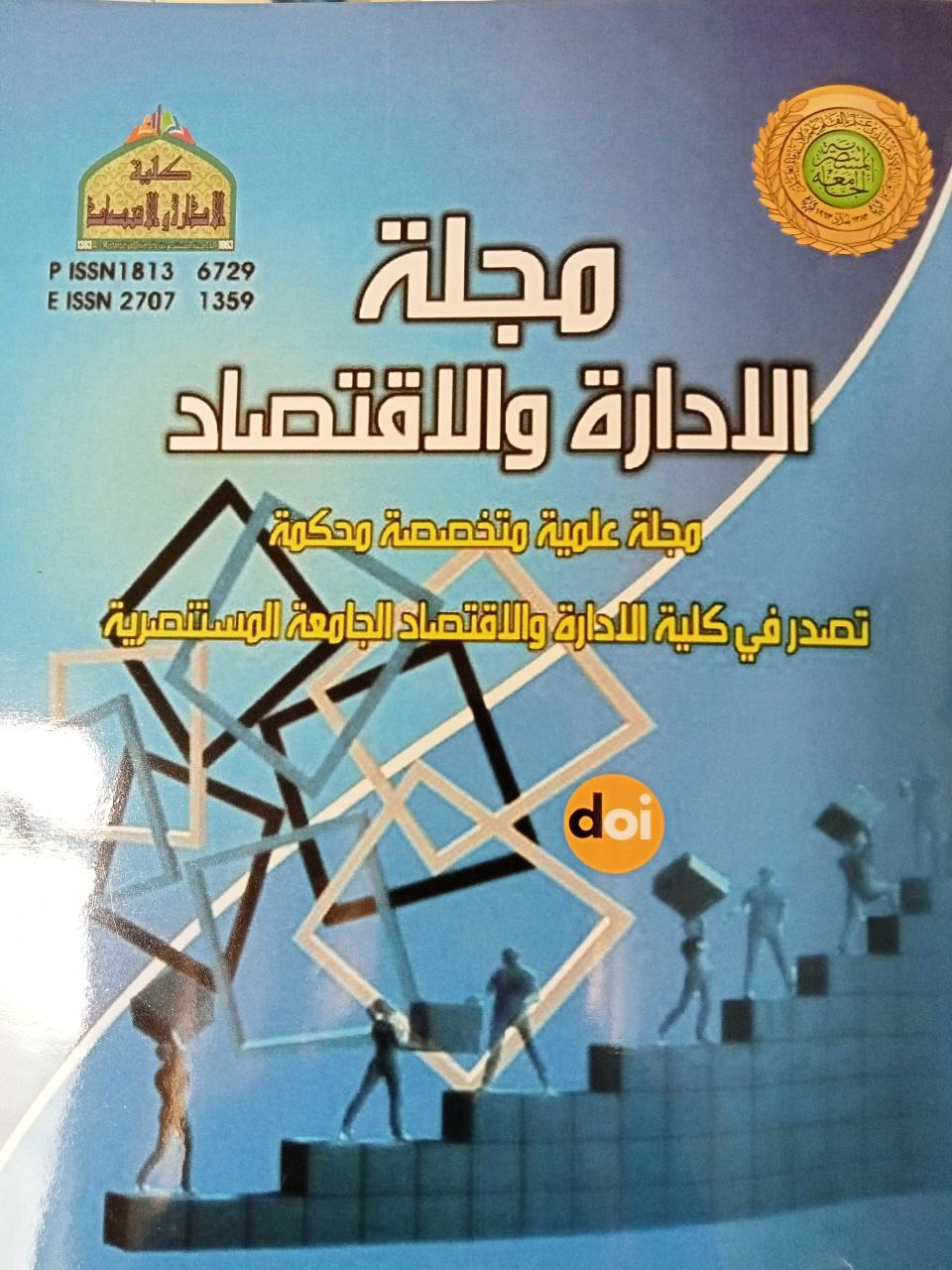تأثير بطاقة الأداء المتوازن المستدامة لاتخاذ القرارات الاستراتيجية في ظل ظروف تنافسية وظروف مناخية غير مؤكدة دليل من العراق
DOI:
https://doi.org/10.31272/jae.i128.83الكلمات المفتاحية:
صنع القرار ، السياسة الخارجية ، التقييم، ديناميكيات نظام الاستدامةالملخص
يهدف هذا البحث الى استخدام بطاقة أداء متوازنة مستدامة(BSC) ، لتوفير نموذج جديد من أجل اتخاذ قرارات استراتيجية في ظل مناخ مضطرب. يتم استخدام نهج TOPSIS الغامض لاختيار المتغيرات البيئية ، والتي يتم تطبيقها بعد ذلك على نموذج BSC مستدام للوحدة الاقتصادية ، إذ ينقسم نموذج اتخاذ القرار إلى ثلاثة متغيرات رئيسة: "متفائل" (نص تطوير اقتصادي) ، و "واقعي" (حالة اقتصادية طبيعية طويلة المدى) ، و "متشائم" ، بالإضافة إلى متغيرين هما السياسة الداخلية، وتعظيم الإنتاجية. بالنسبة لنموذج BSC الهرمي ، تتم محاكاة النموذج بشكل مستقل في كل موقف واستراتيجية ، ويتم دراسة كل ميزة مهمة للوحدة الاقتصادية ، من أجل زيادة الربحية والقدرة على البقاء في المدى الطويل. إذ تشير النتائج إلى أنه في كل حالة ، يتم تفضيل استراتيجية معينة ، والتي قد تساعد الادارة في اتخاذ القرارات الاستراتيجية في المواقف المتقلبة والفوضوية. نظرًا للتطور المتزايد للوحدات الاقتصادية في عالم اليوم التنافسي ، يجب اقتراح أطر تقييم الأداء، إذ يعد نهج "بطاقة الأداء المتوازن (BSC)" أحد الأساليب الأكثر استخدامًا لقياس كفاءة المشروع والتي يمكن تكييفها مع مواقف معينة. هذه الدراسة فريدة من نوعها من حيث أنها تدمج القضايا البيئية في نموذج BSC ديناميكي للوحدة الاقتصادية.
التنزيلات
المراجع
[1] E. Trisyulianti, K. Suryadi, and B. Prihantoro, “A Conceptual Framework of Sustainability Balanced Scocecard for State-Owned Plantation Enterprises,” in 2020 7th International Conference on Frontiers of Industrial Engineering (ICFIE), 2020, pp. 62–66.
[2] A. Rabbani, M. Zamani, A. Yazdani-Chamzini, and E. K. Zavadskas, “Proposing a new integrated model based on sustainability balanced scorecard (SBSC) and MCDM approaches by using linguistic variables for the performance evaluation of oil producing companies,” Expert Syst. Appl., vol. 41, no. 16, pp. 7316–7327, 2014.
[3] H. Zhao and N. Li, “Evaluating the performance of thermal power enterprises using sustainability balanced scorecard, fuzzy Delphic and hybrid multi-criteria decision making approaches for sustainability,” J. Clean. Prod., vol. 108, pp. 569–582, 2015.
[4] S. Agrawal, R. K. Singh, and Q. Murtaza, “Outsourcing decisions in reverse logistics: Sustainable balanced scorecard and graph theoretic approach,” Resour. Conserv. Recycl., vol. 108, pp. 41–53, 2016.
[5] J.-S. Kang, C.-F. Chiang, K. Huangthanapan, and S. Downing, “Corporate social responsibility and sustainability balanced scorecard: The case study of family-owned hotels,” Int. J. Hosp. Manag., vol. 48, pp. 124–134, 2015.
[6] M.-T. Lu, C.-C. Hsu, J. J. H. Liou, and H.-W. Lo, “A hybrid MCDM and sustainability-balanced scorecard model to establish sustainable performance evaluation for international airports,” J. Air Transp. Manag., vol. 71, pp. 9–19, 2018.
[7] F. Figge, T. Hahn, S. Schaltegger, and M. Wagner, “The sustainability balanced scorecard–linking sustainability management to business strategy,” Bus. Strateg. Environ., vol. 11, no. 5, pp. 269–284, 2002.
[8] C. A. L. Vanegas, G. A. Cordeiro, C. P. de Paula, R. E. C. Ordoñez, and R. Anholon, “Analysis of the utilization of tools and sustainability approaches in the product development process in Brazilian industry,” Sustain. Prod. Consum., vol. 16, pp. 249–262, 2018.
[9] I. E. Nikolaou and T. A. Tsalis, “Development of a sustainable balanced scorecard framework,” Ecol. Indic., vol. 34, pp. 76–86, 2013.
[10] A. N. Junior, M. C. de Oliveira, and A. L. Helleno, “Sustainability evaluation model for manufacturing systems based on the correlation between triple bottom line dimensions and balanced scorecard perspectives,” J. Clean. Prod., vol. 190, pp. 84–93, 2018.
[11] C. S. Pedamallu, L. Ozdamar, H. Akar, G.-W. Weber, and A. Özsoy, “Investigating academic performance of migrant students: A system dynamics perspective with an application to Turkey,” Int. J. Prod. Econ., vol. 139, no. 2, pp. 422–430, 2012.
[12] O. Tang and J. Rehme, “An investigation of renewable certificates policy in Swedish electricity industry using an integrated system dynamics model,” Int. J. Prod. Econ., vol. 194, pp. 200–213, 2017.
[13] G. Ozcan-Deniz and Y. Zhu, “A system dynamics model for construction method selection with sustainability considerations,” J. Clean. Prod., vol. 121, pp. 33–44, 2016.
[14] J. Sterman, “System Dynamics: systems thinking and modeling for a complex world,” 2002.
[15] D. C. de Salles, A. C. G. Neto, and L. G. Marujo, “Using fuzzy logic to implement decision policies in system dynamics models,” Expert Syst. Appl., vol. 55, pp. 172–183, 2016.
[16] S. Ahmad, R. M. Tahar, F. Muhammad-Sukki, A. B. Munir, and R. A. Rahim, “Application of system dynamics approach in electricity sector modelling: A review,” Renew. Sustain. Energy Rev., vol. 56, pp. 29–37, 2016.
[17] I. Nikolaou, K. Evangelinos, and W. Leal Filho, “A system dynamic approach for exploring the effects of climate change risks on firms’ economic performance,” J. Clean. Prod., vol. 103, pp. 499–506, 2015.
[18] R. Poles, “System Dynamics modelling of a production and inventory system for remanufacturing to evaluate system improvement strategies,” Int. J. Prod. Econ., vol. 144, no. 1, pp. 189–199, 2013.
[19] T. Zhang and L. Gao, “Study on the Application of Dynamic Balanced Scorecard in the Service Industry,” in 2008 International Conference on Intelligent Computation Technology and Automation (ICICTA), 2008, vol. 1, pp. 1158–1162.
[20] R. Espejo, S. B. Khakbaz, and N. Hajiheydari, “Proposing a basic methodology for developing balanced scorecard by system dynamics approach,” Kybernetes, 2015.
[21] Z. Hoque, F. Barnabè, and C. Busco, “The causal relationships between performance drivers and outcomes,” J. Account. Organ. Chang., 2012.
[22] M. Zandieh, S. Y. Shariat, M. Rabieh, and M. Tootooni, “A new framework for dynamic sustainability balanced scorecard in order to strategic decision making in a turbulent environment,” J. Ind. Syst. Eng., vol. 12, no. 4, pp. 107–135, 2020.
[23] S. Nielsen and E. H. Nielsen, “System dynamics modelling for a balanced scorecard,” Manag. Res. News, 2008.
[24] F. Barnabè, “A ‘system dynamics‐based Balanced Scorecard’ to support strategic decision making,” Int. J. Product. Perform. Manag., 2011.
[25] E. Supino, F. Barnabè, M. C. Giorgino, and C. Busco, “Strategic scenario analysis combining dynamic balanced scorecards and statistics,” Int. J. Product. Perform. Manag., 2019.
[26] S. Koul, O. A. Falebita, J.-F. K. Akinbami, and J. B. Akarakiri, “System dynamics, uncertainty and hydrocarbon resources modelling: A systematic review,” Renew. Sustain. Energy Rev., vol. 59, pp. 199–205, 2016.
[27] W. E. Walker et al., “Defining uncertainty: a conceptual basis for uncertainty management in model-based decision support,” Integr. Assess., vol. 4, no. 1, pp. 5–17, 2003.
[28] R. Vecchiato, “Environmental uncertainty, foresight and strategic decision making: An integrated study,” Technol. Forecast. Soc. Change, vol. 79, no. 3, pp. 436–447, 2012.
[29] Y. Barlas, “Formal aspects of model validity and validation in system dynamics,” Syst. Dyn. Rev. J. Syst. Dyn. Soc., vol. 12, no. 3, pp. 183–210, 1996.

التنزيلات
منشور
إصدار
القسم
الفئات
الرخصة
الحقوق الفكرية (c) 2021 مجلة الإدارة والاقتصاد

هذا العمل مرخص بموجب Creative Commons Attribution 4.0 International License.
مجلة الإدارة والاقتصاد هي مجلة مفتوحة المصدر حيث تكون جميع محتوياتها مجانية. تخضع مقالات هذه المجلة لشروط ترخيص المشاع الإبداعي المنسوب إلى المؤلف (CC-BY 4.0) (https://creativecommons.org/licenses/by/4.0/legalcode) الذي يسمح للمرخص لهم دون قيود بالبحث عن النص الكامل للمقالات أو تنزيله أو مشاركته أو توزيعه أو طباعته أو ربطه به، وفحصه للفهرسة وإعادة إنتاج أي وسيلة للمقالات بشرط أن ينسبوا إلى المؤلفين الفضل في ذلك (الاستشهاد). تسمح المجلة للمؤلفين بالاحتفاظ بحقوق الطبع والنشر لمقالهم المنشور.
. Creative Commons-Attribution (BY)









